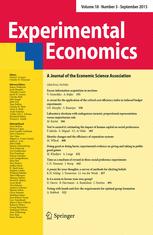 The authors of a paper that examined the best way to inspire creativity in the workplace have issued an erratum after they “failed to cite some very relevant recent papers in experimental economics.”
The authors of a paper that examined the best way to inspire creativity in the workplace have issued an erratum after they “failed to cite some very relevant recent papers in experimental economics.”
The paper, “Incentives for creativity,” was published by Experimental Economics only a few months ago — in May — by two researchers from the University of California San Diego and the University of Amsterdam. Sanjiv Erat and Uri Gneezy found that incentives don’t actually improve creativity, and competitive incentives can actually reduce creativity.
The notice updates the paper with references to four studies published between 2012 and 2015:
In our paper “Incentives for Creativity” (Erat and Gneezy 2015), we failed to cite some very relevant recent papers in experimental economics. We wish to correct this in the discussion below.
Bradler et al. (2014) run a laboratory experiment with over a thousand subjects looking into how rewards affect performance in a creative and in a routine task. They find that tournament incentives work well in both tasks, suggesting that creative performance is not subject to motivational crowding out. They also look at unconditional wage gifts. Interestingly, wage gifts induce reciprocity only in the routine task. They run additional treatments to investigate this asymmetry and find that it is the uncertainty about ones exact performance, and, hence, the lack of control over the back-transfer to the principal, that inhibits reciprocity in the creative task.
Charness and Grieco (2012) consider the effect of incentives on individual creativity. They present a series of experiments on creativity where subjects face creativity tasks where, in one case, ex-ante goals and constraints are imposed on their answers, and in the other case no restrictions apply. The effect of financial incentives on creativity is then tested. Their findings provide striking evidence that financial incentives affect “closed” (constrained) creativity, but do not facilitate “open” (unconstrained) creativity.
Laske and Schröder (2015) investigate how incentives affect creative performance. They introduce a novel real effort task that allows to objectively quantify performance in multiple dimensions of creative work, i.e. quantity, quality, and novelty. In three treatments and a baseline, they separately incentivize each dimension by introducing piece-rate incentives. They find that incentivizing quantity and incentivizing novelty have a positive effect on both quantity and novelty. They find negative spillover effects of incentivizing quantity on the quality. The increases in quantity is in line with payoff-maximization, while the other effects seem to be due to distortion of effort. Combining all three dimensions of creativity, they find that incentivizing novelty results in the highest overall creative output.
Eckartz et al. (2013) compare performance in a word based creativity task under three incentive schemes: a flat fee, a linear payment and a tournament. Furthermore, we also compare performance under two control tasks (Raven’s advanced progressive matrices or a number-adding task) with the same treatments. In all tasks we find that incentives seem to have very small effects and that differences in performance are predominantly related to individual skills.
(Even though the authors say “we” while describing the Eckartz et al experiment, neither one is listed as an author on that paper.)
Journal editor David Cooper, a professor at Florida State University, said that the authors contacted him about making the changes:
I was contacted by the authors of the paper after it had been put online. They let me know that they had failed to cite some relevant papers and asked if they could modify the text. After checking with our production staff, I let them know that the existing article could not be modified but we could publish an erratum. This led to the published erratum.
Second author Gneezy didn’t respond to questions about the last paragraph of the notice, and said they simply forgot to include the references:
Sometimes things are just as simple as they seem. We forgot to include the relevant recent literature in experimental economics, so we fixed it. No one complained.
Oliver Kirchkamp, second author on the paper referenced in the notice’s last paragraph, said that Erat and Gneezy cited them without prompting:
We are, of course, glad to see that Erat and
Gneezy cite our paper. As far as we understand they do this on their own accord. We never contacted them in this matter.
Hat tip: Rolf Degen
Like Retraction Watch? Consider making a tax-deductible contribution to support our growth. You can also follow us on Twitter, like us on Facebook, add us to your RSS reader, and sign up on our homepage for an email every time there’s a new post. Click here to review our Comments Policy.
It may not come as a surprise to find that, when one finds the Eckartz et al preprint (weirdly described as a “mimeo” in Erat & Gneezy’s references), available on-line at co-author Kirchkamp’s Researchgate page, everything in the last paragraph of the notice, except for “Eckartz et al. (2013) ” at the beginning, is identical to everything in the abstract of the cited paper, except for “We” at the beginning.
Someone with even more spare time than I might want to compare the other paragraphs of the notice to the references cited therein.